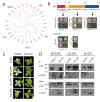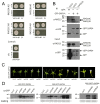Phytoplasma effector SAP54 hijacks plant reproduction by degrading MADS-box proteins and promotes insect colonization in a RAD23-dependent manner
- PMID: 24714165
- PMCID: PMC3979655
- DOI: 10.1371/journal.pbio.1001835
Phytoplasma effector SAP54 hijacks plant reproduction by degrading MADS-box proteins and promotes insect colonization in a RAD23-dependent manner
Abstract
Pathogens that rely upon multiple hosts to complete their life cycles often modify behavior and development of these hosts to coerce them into improving pathogen fitness. However, few studies describe mechanisms underlying host coercion. In this study, we elucidate the mechanism by which an insect-transmitted pathogen of plants alters floral development to convert flowers into vegetative tissues. We find that phytoplasma produce a novel effector protein (SAP54) that interacts with members of the MADS-domain transcription factor (MTF) family, including key regulators SEPALLATA3 and APETALA1, that occupy central positions in the regulation of floral development. SAP54 mediates degradation of MTFs by interacting with proteins of the RADIATION SENSITIVE23 (RAD23) family, eukaryotic proteins that shuttle substrates to the proteasome. Arabidopsis rad23 mutants do not show conversion of flowers into leaf-like tissues in the presence of SAP54 and during phytoplasma infection, emphasizing the importance of RAD23 to the activity of SAP54. Remarkably, plants with SAP54-induced leaf-like flowers are more attractive for colonization by phytoplasma leafhopper vectors and this colonization preference is dependent on RAD23. An effector that targets and suppresses flowering while simultaneously promoting insect herbivore colonization is unprecedented. Moreover, RAD23 proteins have, to our knowledge, no known roles in flower development, nor plant defence mechanisms against insects. Thus SAP54 generates a short circuit between two key pathways of the host to alter development, resulting in sterile plants, and promotes attractiveness of these plants to leafhopper vectors helping the obligate phytoplasmas reproduce and propagate (zombie plants).
Conflict of interest statement
The authors have declared that no competing interests exist.
Figures





Comment in
-
Bacterial pathogenicity: Phytoplasma converts plants into zombies.Nat Rev Microbiol. 2014 Jun;12(6):393. doi: 10.1038/nrmicro3283. Nat Rev Microbiol. 2014. PMID: 24830466 No abstract available.
References
-
- Dean P (2011) Functional domains and motifs of bacterial type III effector proteins and their roles in infection. FEMS Microbiol Rev 35: 1100–1125. - PubMed
-
- Bozkurt TO, Schornack S, Banfield MJ, Kamoun S (2012) Oomycetes, effectors, and all that jazz. Curr Opin Plant Biol 15: 483–492. - PubMed
-
- Romer P, Recht S, Strauss T, Elsaesser J, Schornack S, et al. (2010) Promoter elements of rice susceptibility genes are bound and activated by specific TAL effectors from the bacterial blight pathogen, Xanthomonas oryzae pv. oryzae. New Phytol 187: 1048–1057. - PubMed
-
- Roy BA (1993) Floral mimicry by a plant pathogen. Nature 362: 56–58.
Publication types
MeSH terms
Substances
Grants and funding
LinkOut - more resources
Full Text Sources
Other Literature Sources
Molecular Biology Databases
Miscellaneous

